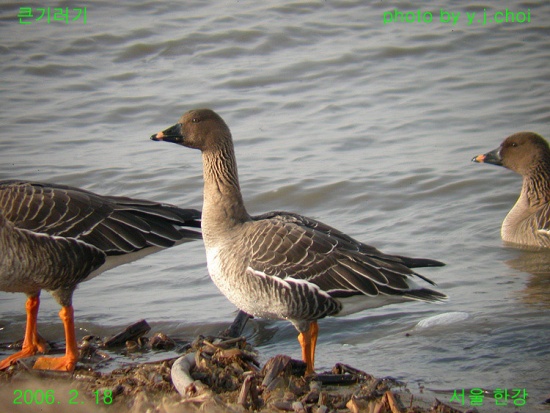- Anser fabalis
Identification
Taiga form
- Dark goose with a long neck
- Head, neck, and back are dark brownish
- Lightest on the back
- Underside is lighter
- Bill is quite long
- Very variable with regards to extent of black and orange
- Orange often found on the distal part and almost always more extensive than in the Tundra form
- May be a narrow white edge between bill and feathers on the head, especially above the bill.
In flight, tail pattern is conspicuous: narrow white terminal band, broader black band, and the innermost part white. Belly is white. Both upper and lower sides of wings are dark, without much contrast between coverts and primaries/secondaries.
Tundra form
Similar to Taiga form
- Neck is shorter and heavier
- Bill is shorter than in the Taiga form (not much longer than it is high)
- Birds with more than a small orange spot near the tip of the bill are rare in this form
- Orange is always sharply defined (mostly more diffusely edged in the Taiga form)
Juvenile forms are more scaly on the back and lack the white at the base of the bill.
Distribution
A small population regularly winter in the Falkirk area of Scotland.
Taxonomy
- Subspecies fabilis is often called Taiga Bean Goose (Anser fabilis) together with subspecies johanseni and middendorfii, and occurs from Scandinavia to the Ural Mountains to Lake Baikal, and into eastern Siberia (johanseni and middendorfii does not seem to be recognized by all authorities).
- Subspecies rossicus together with serrirostris is often called Tundra Bean Goose (Anser rossicus) and occurs from Northern Russia to north-east Siberia.
Both forms occur in Europe in winter, with northernmost flocks almost exclusively belonging to the Taiga form.
The two forms (Taiga vs Tundra) are recognized as full species by several authorities, but not currently by Sibley and Monroe which the Opus database is based upon.
Habitat
Breeds in Tundra and humid openings in northern forest, especially birch and coniferous forests. Winters in agricultural areas, mostly grassy fields.
Behaviour
It grazes in bean field stubbles, giving rise to its name. The diet includes crops such as grass, cereals and potatoes.
Vocalisation
<flashmp3>Anser fabalis (song).mp3</flashmp3>
Listen in an external program





